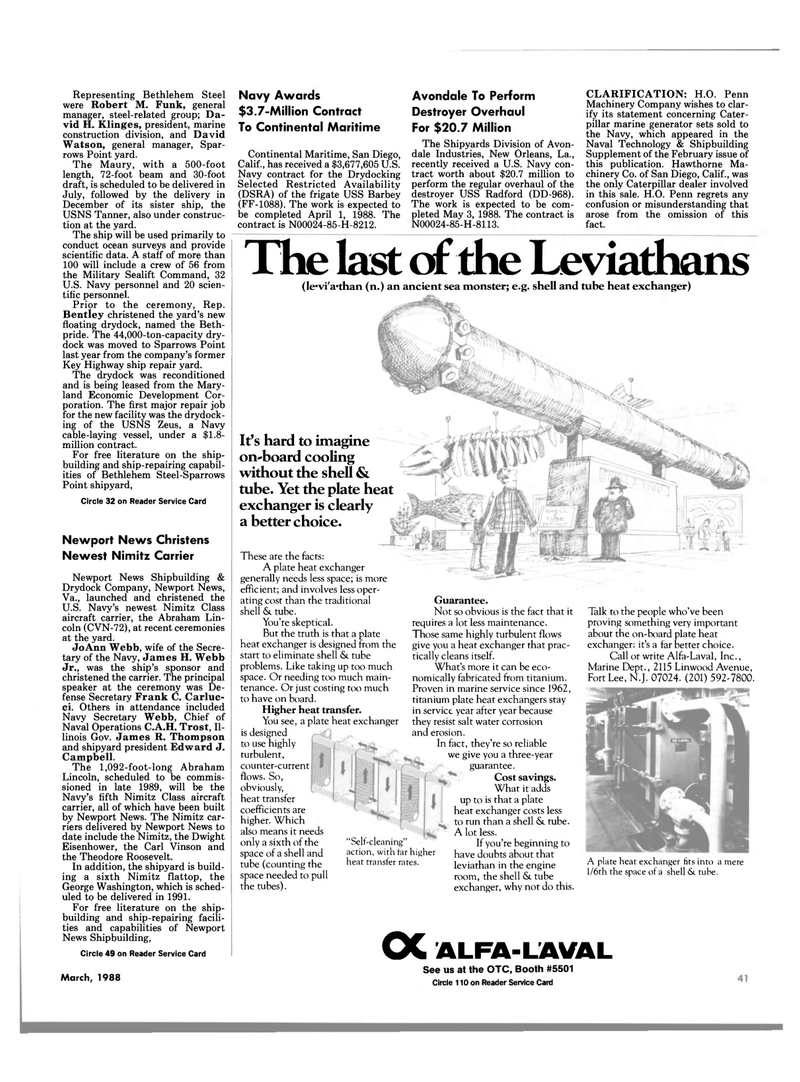
Page 39: of Maritime Reporter Magazine (March 1988)
Read this page in Pdf, Flash or Html5 edition of March 1988 Maritime Reporter Magazine
Representing Bethlehem Steel were Robert M. Funk, general manager, steel-related group; Da- vid H. Klinges, president, marine construction division, and David
Watson, general manager, Spar- rows Point yard.
The Maury, with a 500-foot length, 72-foot beam and 30-foot draft, is scheduled to be delivered in
July, followed by the delivery in
December of its sister ship, the
USNS Tanner, also under construc- tion at the yard.
The ship will be used primarily to conduct ocean surveys and provide scientific data. A staff of more than 100 will include a crew of 56 from the Military Sealift Command, 32
U.S. Navy personnel and 20 scien- tific personnel.
Prior to the ceremony, Rep.
Bentley christened the yard's new floating drydock, named the Beth- pride. The 44,000-ton-capacity dry- dock was moved to Sparrows Point last year from the company's former
Key Highway ship repair yard.
The drydock was reconditioned and is being leased from the Mary- land Economic Development Cor- poration. The first major repair job for the new facility was the drydock- ing of the USNS Zeus, a Navy cable-laying vessel, under a $1.8- million contract.
For free literature on the ship- building and ship-repairing capabil- ities of Bethlehem Steel-Sparrows
Point shipyard,
Circle 32 on Reader Service Card
Newport News Christens
Newest Nimitz Carrier
Newport News Shipbuilding &
Drydock Company, Newport News,
Va., launched and christened the
U.S. Navy's newest Nimitz Class aircraft carrier, the Abraham Lin- coln (CVN-72), at recent ceremonies at the yard.
JoAnn Webb, wife of the Secre- tary of the Navy, James H. Webb
Jr., was the ship's sponsor and christened the carrier. The principal speaker at the ceremony was De- fense Secretary Frank C. Carluc- ci. Others in attendance included
Navy Secretary Webb, Chief of
Naval Operations C.A.H. Trost, Il- linois Gov. James R. Thompson and shipyard president Edward J.
Campbell.
The 1,092-foot-long Abraham
Lincoln, scheduled to be commis- sioned in late 1989, will be the
Navy's fifth Nimitz Class aircraft carrier, all of which have been built by Newport News. The Nimitz car- riers delivered by Newport News to date include the Nimitz, the Dwight
Eisenhower, the Carl Vinson and the Theodore Roosevelt.
In addition, the shipyard is build- ing a sixth Nimitz flattop, the
George Washington, which is sched- uled to be delivered in 1991.
For free literature on the ship- building and ship-repairing facili- ties and capabilities of Newport
News Shipbuilding,
Circle 49 on Reader Service Card
March, 1988
Navy Awards $3.7-Million Contract
To Continental Maritime
Continental Maritime, San Diego,
Calif., has received a $3,677,605 U.S.
Navy contract for the Drydocking
Selected Restricted Availability (DSRA) of the frigate USS Barbey (FF-1088). The work is expected to be completed April 1, 1988. The contract is N00024-85-H-8212.
Avondale To Perform
Destroyer Overhaul
For $20.7 Million
The Shipyards Division of Avon- dale Industries, New Orleans, La., recently received a U.S. Navy con- tract worth about $20.7 million to perform the regular overhaul of the destroyer USS Radford (DD-968).
The work is expected to be com- pleted May 3, 1988. The contract is
N00024-85-H-8113.
CLARIFICATION: H O. Penn
Machinery Company wishes to clar- ify its statement concerning Cater- pillar marine generator sets sold to the Navy, which appeared in the
Naval Technology & Shipbuilding
Supplement of the February issue of this publication. Hawthorne Ma- chinery Co. of San Diego, Calif., was the only Caterpillar dealer involved in this sale. H.O. Penn regrets any confusion or misunderstanding that arose from the omission of this fact.
The last of the Leviathans (Icvi'a-than (n.) an ancient sea monster; e.g. shell and tube heat exchanger)
OC ALFA-LAVAL
See us at the OTC, Booth #5501
Circle 110 on Reader Service Card
It's hard to imagine on-board cooling without the shell & tube. Yet the plate heat exchanger is clearly a better choice.
These are the facts:
A plate heat exchanger generally needs less space; is more efficient; and involves less oper- ating cost than the traditional shell & tube.
You're skeptical.
But the truth is that a plate heat exchanger is designed from the start to eliminate shell & tube problems. Like taking up too much space. Or needing too much main- tenance. Or just costing too much to have on board.
Higher heat transfer.
You see, a plate heat exchanger is designed to use highly turbulent, counter-current flows. So, obviously, heat transfer coefficients are higher. Which also means it needs only a sixth of the space of a shell and tube (counting the space needed to pull the tubes). "Self-cleaning" action, with tar higher heat transfer rates.
Guarantee.
Not so obvious is the fact that it requires a lot less maintenance.
Those same highly turbulent flows give you a heat exchanger that prac- tically cleans itself.
What's more it can be eco- nomically fabricated from titanium.
Proven in marine service since 1962, titanium plate heat exchangers stay in service year after year because they resist salt water corrosion and erosion.
In fact, they're so reliable we give you a three-year guarantee.
Cost savings.
What it adds up to is that a plate heat exchanger costs less to run than a shell & tube.
A lot less.
If you're beginning to have doubts about that leviathan in the engine room, the shell & tube exchanger, why not do this.
A plate heat exchanger fits into a mere l/6th the space of a shell &. tube.
Talk to the people who've been proving something very important about the on-board plate heat exchanger: it's a far better choice.
Call or write Alfa-Laval, Inc.,
Marine Dept., 2115 Linwood Avenue,
Fort Lee, N.J. 07024- (201) 592-7800.

 38
38

 40
40
